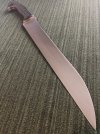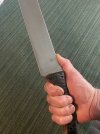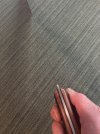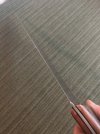Sure, but again, as I've stated. The reason why most knives are thicker than they need to be is almost entirely due to marketing, and customers who use knives as non-knife tools. The issue is that when these knives break, these idiot customers then try to blame the maker/manufacturer, not themselves for abusing a tool by using it as something it wasn't meant to be. If this wasn't the case, then that means that 90% of all knifemakers and manufacturers have slipped and hit their heads in the shower and made the collective decision to all start producing knives that make better wood-splitting implements than knives. Mass psychosis is no joke.
Secondly, I don't buy the posited theory from
 rodriguezryan14
rodriguezryan14
whatsoever. So wait, let me see if I have this right. Modern supersteels are harder, tougher, and stronger than old steels....but we need to run 'em thicker because they're chippier? What? LOL Sounds to me like a heat-treat issue. In fact, a common refrain around here is that we wish these companies using these modern steels would take advantage of those advantages and run 'em thinner because the steels can take it.
Criminy. It's ok to want and enjoy thick knives, no one is telling anyone they aren't allowed to enjoy things. But it's a trend that is irritating for those of us who want a knife that actually cuts well. Incidentally, it should be noted that I've defended Medfords in the past, as they had a nice very slicey hollow-grind on their Praetorians, so even though it was a giant slab of D2, it still sliced very well. Any outdoors cutting tasks I do, I do with thinner knives, and have never had an issue, so the idea that we need thick blades is more or less absurd. My Dad was a deer hunter for something like 20 years, and broke down plenty of animals with his Buck 110. Odd, considering that we have a knifemaker here telling us we need thick knives in order to break down animals, when through my own direct observation, that's false.

But for YouBoob batoning and coked-out chipmunks like those two Dutch guys or JoeX, I could see how thick knives are preferred. They make better videos*.
* Also not a knife task.






